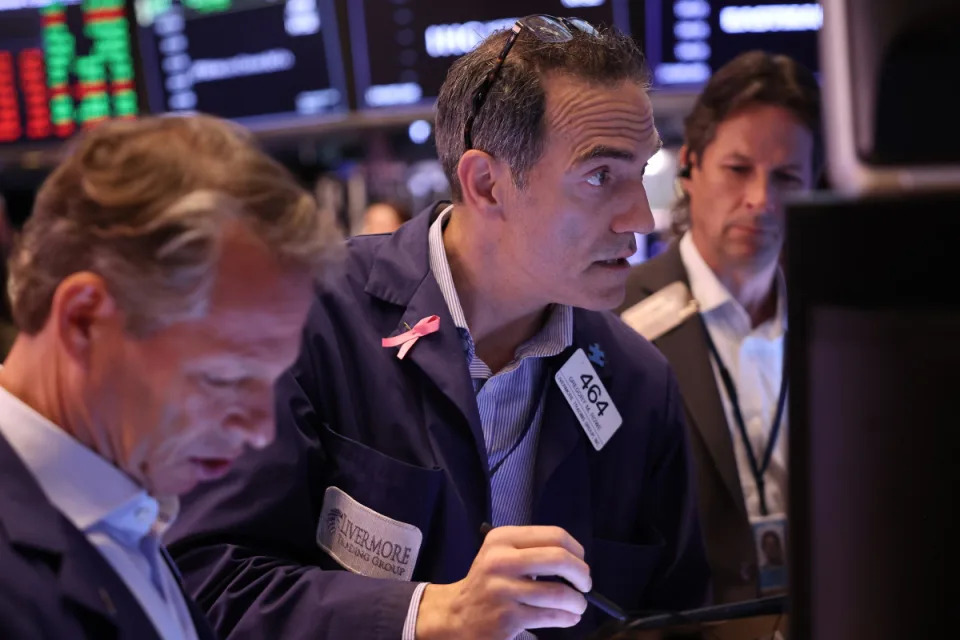After a drubbing, market searches for its mojo
September is September. It just drives investors and Wall Street crazy.
Everyone comes back from summer vacation, happy, maybe even relaxed. And then the stock market basically says, "Don't get cocky."
September sure happened last week, and the unease is growing.
The Standard & Poor's 500 Index dropped 4.3% on the week, its worst weekly loss since a 4.7% decline in September 2022. The Nasdaq Composite Index slumped 5.77%, its worst weekly loss since January 17, 2022.
Related: Nordstrom joins forces with surprising Latin American counterpart
The concern is two-fold:
So, September gets to play, well, September. Between 2014 and 2023, stocks have fallen in September seven times. The month has been the worst month for stocks overall since 1950, according to the Stock Traders Almanac .
But declines for the S&P 500 and the Dow since stocks peaked this summer have been modest: 4.6% since the S&P intraday peak of 5,669.67 on July 16 and just 3% since the Dow peaked at 41,585.21 on Aug. 30.
The Nasdaq and Nasdaq-100 indexes, dominated by tech and big tech, are a different story:
The declines should not surprise. Both indexes were seriously overbought in early July and increasingly vulnerable to short-sellers. Nvidia ( NVDA ) has fallen 27.3% since peaking at $140.76 on June 20.
The calendar ahead is light on earnings — Oracle ( ORCL ) , due Monday, is probably the biggest report. The week also offers two important reports that can produce volatility: the Consumer Price Index report on Wednesday and the Producer Price Index on Thursday.
It's the Fed meeting on Sept. 17-18 everyone in markets is waiting for. The betting is the central bank will cut its key rate from 5.25%-to-5.5% to 5% to 2.5%, with more cuts to follow.
Apple will unveil new and upgraded iPhones
But there is one event that could get traders excited: Apple's ( AAPL ) big product announcement event, known as "It's Glowtime" on Monday.
The event, which starts at 1 p.m. ET, will be focused on the iPhone, its biggest source of revenue.
The event is expected to feature at least some new iPhone models, updates to the Apple Watch and perhaps some intelligence on Apple Intelligence, the company's effort to work artificial intelligence into its products.
Apple shares are up 14.7% in 2024, third among the Magnificent 7 stocks after Nvidia, up 107.7% and Facebook parent Meta Platforms ( META ) , up 41.3%.
But Apple was also, relatively speaking, the best Mag 7 performer on Friday, down just 0.7% on the day. It was the second Mag 7 stock on the week, down 3.6%, behind Tesla ( TSLA ) , down 1.6%.
More Wall Street Analysts:

Michael M. Santiago/Getty Images
Why the market had such a very bad week
Several reports on manufacturing orders and employment and construction, all released on Tuesday, the first trading day after Labor Day, were weaker than expected and suggested business was slowing — but, importantly, NOT contracting.
The Friday jobs report showed fewer jobs created in August than projected. And job creation estimates from June and July were reduced. Again, more evidence of a slowing economy.
The reports fed into a Wall Street fear that the insistence of the Fed and Fed Chairman Jerome Powell on making decision based on data was delaying rate cuts and hurting the economy.
This is what may happen next week
The calendar will offer some opportunities. If markets appreciate the Apple iPhone extravaganza and the Oracle earnings, that could offer a lift.
Database giant Oracle is expected to earn $1.32 a share, up from $1.19 a year ago. Revenue is projected at $13.2 billion, up from $12.45 billion.
The shares are up 34.5% this year, compared with 13.4% for the S&P 500 and 11.2% for the Nasdaq. The shares are only 3.3% off their 52-week high, compared with 27% for Nvidia. And Oracle hasn't broken its 50-day moving average since the end of 2022 — a signal of investor confidence.
Lastly, its relative strength index is under 70, a sign it's not overbought. Relative strength is a measure of momentum. The higher the index, the more a market is moving too high too fast.
Two other reports to watch: Gamestop ( GME ) , the video-game retailer, and Adobe ( ADBE ) .
Gamestop shares are up 36% this year, though the consensus estimate for this quarter is a loss of 8 cents a share, down from a loss of 3 cents a year ago. Revenue is estimated at $895 million, down 23% from a year ago.
The earnings estimate for Adobe, a key player in digital imaging, cloud computing and other tasks, is $4.62 a share, up from $3.98 a year ago. Revenue $5.4 billion would be up about 10% from a year ago. Shares are down 5.5% this year.
A bottom may not be far off
Assuming the economy is not falling off a cliff, the averages may be starting to close in on a bottom.
The bottom to look for on the S&P 500 is the 200-day moving average, or about 5,100. The Nasdaq's relative strength index finished Friday at 37. Below 30 means it's oversold. At its peak in July, the S&P's RSI hit 80, and has been driving lower since.
That leaves two wild cards: the CPI and PPI. They should be benign. Job growth is slowing. Interest rates are lower . Oil prices are down.Gasoline prices nationally will drop below $3 a gallon this fall. The national average Saturday was $3.281, but 11 states, all southern, are seeing prices below $3 already.
Related: Veteran fund manager sees world of pain coming for stocks




